In November 2019 we published our Sony A7R IV Sensor review. The Sony scored an excellent 99 points, securing a top-ten position in our Sensor ranking. In this article, we use the data from the A7R IV Sensor tests to recompute the results for a total of 25 Sony-compatible E-mount lenses so that you can now select the Sony A7R IV as a camera option when browsing our lens database and making comparisons.
The list includes prime and zoom lenses from Sony and Carl Zeiss and covers focal lengths from 21 to 400mm. We have separated the primes from the zooms in the following sections and categorized them into wide-angle, standard, and telephoto lenses. Hopefully this will give you a better idea of which lenses work best on the A7RIV and help you find the right model for your specific style of photography or project.
Prime lenses
We updated a total of 15 prime lens reviews using the Sony A7RIV Sensor test results. The best performers are the Sony FE Carl Zeiss Sonnar T* 55mm F1.8 ZA and the Sony FE 85mm F1.4 GM, which both scored an excellent 49 points. However, other lenses did very well, too, making them ideal companions for the A7R IV. Let’s have a look at all the categories.
Wide-angle primes
We have five lenses in this category, with prices ranging from $450 up to $1600. Among those is the 21mm Carl Zeiss Loxia; while understandably not one of the top three best-performing models that we’re going to look at more closely, it easily matches them for peak sharpness, so it shouldn’t be dismissed. And although in last place, the Sony Zeiss 35mm F2.8 is also an excellent performer, though $800 isn’t exactly cheap for a f/2.8 lens.
Per its higher DXOMARK score, the best all-round performer is the $1299 Carl Zeiss Batis 25mm F2, but with only one more point, it is more or less tied with the $1600 Sony Zeiss Distagon FE 35mm F1.4. In third place is the Sony FE 28mm F2. At just $450, it’s a great performer for the price, but as always with lenses, it’s well worth taking a closer look at the performance at different apertures.
Wide open, the Sony Zeiss Distagon isn’t all that strong a performer in terms of sharpness, at least in the center of the frame (indicated by the 0% field position). On the plus side, though, it has consistent sharpness across the field right out to the corners; even so, we expect higher levels on a modern lens like this. At f/2 (shown in the Acutance profiles above), the Distagon has very high central sharpness, but it’s still not on the same level as the wider 25mm Batis, which has very high central sharpness and high corner sharpness as well at its initial aperture. Surprisingly, the Sony 28mm is almost as sharp at f/2 than the 35mm in the center, but It drops off a little in the corners. The best overall performance in terms of sharpness is at f/5.6–f/8, though there’s some astigmatism in the 35mm at f/5.6 that may be noticeable in images. At f/8, however, astigmatism is no longer an issue, and all three share practically indistinguishable profiles in terms of sharpness.
The Zeiss Batis performs exceptionally well in other areas besides sharpness, which is why it has the best DXOMARK score of the group. Although it has the highest and most noticeable vignetting of the five, measured at up to –2.5 stops in the corners at the maximum aperture, distortion is low. Indeed, our tests reveal that it is at the same levels as the Sony Zeiss 35mm and considerably lower than the Sony FE 28mm.
The Batis also has the lowest levels of lateral chromatic aberration (LCA). Even the Sony Zeiss 35mm F1.4 has higher levels of LCA (measured at 8 microns at its highest) at the wider apertures, which although very good, is still a little higher than we expected. The Sony 28mm F2 is a solid performer in our tests, though its peak LCA of 17 microns is quite high. Fortunately that’s really only visible in the corners and would likely be easily removed with profile correction, either in-camera or when using software.
Standard primes
Sony has this category well covered, with lenses ranging from $250 for the Sony FE 50mm F1.8 up to $1500 for the Sony Zeiss 50mm F1.4. There’s one third-party lens at $950—the Zeiss Loxia 2/50, which comes in at second place, but it is manual focus only, which will limit its appeal. The Sony FE 50mm F2.8 Macro and Sony FE 50mm F1.8 in fourth and fifth place respectively are accessibly priced and very good performers, but the latter’s peak sharpness on the A7R IV is a little lower than we had hoped for.
If you’ve been following our Sony FE mount lens reviews, it will come as little surprise to see the Sony Zeiss 55mm F1.8 ZA head this section. It’s an excellent lens. In second place is the Zeiss Loxia 2/50, which apart from its manual focus is similar in many ways in performance, though it’s not quite at the same level as the Sony Zeiss 55mm F1.8 in overall sharpness. Despite being in third place according to its overall DXOMARK score, the Sony Zeiss 50mm F1.4 has outstanding sharpness, but it’s let down by its T1.8 transmission and high vignetting. As usual, we’ll take a closer look at the sharpness (acutance profiles) across the image field:
Best open aperture performance across the field belongs to the Zeiss Loxia 2/50, though the Sony Zeiss 55mm F1.8 ZA is the most consistent out to the corners. The Sony Zeiss 50mm F1.4 has a strong central core of sharpness at f/2, higher than the Loxia 2/50 and the Sony Zeiss 55mm F1.8 ZA at f/2 (shown above), but sharpness in the corners falls off to levels similar to those of the 55mm.
At f/2.8, the Loxia’s sharpness is outstanding right across the frame, which is what you’re paying for. Nether of the other two can match it, though the Sony Zeiss 55mm F1.8 ZA comes closest. The Loxia at f/2.8 has noticeable astigmatism mid-frame to the corners, though that sometimes translates into attractive rendering. The two Sony Zeiss models achieve their best overall performance at f/5.6, while the Loxia’s realizes its best one stop down from that at f/8, though astigmatism persists.
All three have good control of LCA, the Sony Zeiss 50mm F1.4 especially so, given its faster aperture. LCA is nearly always nonexistent in the image center and mid-frame; however, wide open, the Sony Zeiss 50mm F1.4 does have a little more than the others, as you might expect. Even so, it’s as well controlled as the other two in the corners, where you would expect it to become increasingly worse. Where the F1.4 falls behind the others is in transmission—it is almost the same speed as the 55mm (T1.8 vs. T1.9), and it has higher vignetting wide open. To be fair, the higher vignetting is to be expected and of course lessens with stopping down, but it persists through the aperture range and never really goes away.
Telephoto primes
As the first to market full-frame mirrorless cameras, Sony has a developed an impressive range of short telephoto primes that are ideal for portraits and indoor sports. There’s also an outstanding macro, which can serve double duty as a portrait lens, especially when close-ups are required. (Sony also has some innovative super tele-lenses, though we’ve yet to evaluate them on the A7R IV.) We have five lenses in this group, but with the exception of the delightful Sony FE 85mm F1.8, they’re quite pricey at over $1000. Indeed, the FE 85mm F1.4 has an introductory list price of $1800.
At that price you’d expect the FE 85mm F1.4 to perform well, and it does. It has the highest DXOMARK score of the five and is very well corrected, with negligible distortion, low vignetting, and excellent management of LCA. It also has very good sharpness. It is surprising, then, that the accessibly-priced Sony FE 85mm F1.8 has slightly higher peak sharpness than the F1.4 (55 P-Mpix vs. 47), though that is due in part to some astigmatism in the faster lens. Nevertheless, the Sony FE 85mm F1.8 is also a little sharper than the third place Zeiss Batis 85mm F1.8.
In fairness, all three have very similar sharpness characteristics, though there are some subtle differences between them. When viewed wide open at f/1.4, the Sony FE 85mm F1.4 GM has slightly lower central sharpness than the two F1.8s at f/1.8, and the Batis has slightly lower sharpness than the Sony FE 85mm F1.8 in the outer zones of the frame.
Stopped down a little to f/1.8, the Sony FE 85mm F1.4 quickly matches the two F1.8s, but by f/5.6 the two F1.8 models just pull ahead—at least in the center; the Sony FE 85mm F1.8 surpasses even the Batis in the outer zones and corners. Given the price of the Sony FE 85mm F1.8, this shows just how good a performer it is.
The Batis has the highest distortion and the highest measured vignetting of the three, although wide open, the Sony FE 85mm F1.8 is visually the heaviest-looking. Lateral chromatic aberration is low for all three wide open, though the F1.8s both have increasingly higher levels than the F1.4 when stopping down. It might be pricey, but the Sony FE 85mm F1.4 is worthy of the GM moniker. If you’re a bit pushed to pay that price, however, Sony’s F1.8 lens is a great all-round performer.
Zoom lenses
Wide-angle zoom lenses
Third-party support is good on full-frame primes, but less so with zooms. Manufacturers have tended to concentrate on APS-C format lenses in the past, though that will change, what with companies like Sigma and Tamron keen to get a slice of Sony’s mirrorless FF share. Indeed, we’ve only two models in our database in this category, though we’ve yet to test to Sony’s promising (if pricey) $1,800 FE 12-24mm F4 G. We have, however, tested both of Sony’s 16-35mm zooms—the stabilized F4 Zeiss at $1350 and the $2,200 F2.8 GM version.
As the newer model of the two, the Sony FE 16-35mm F2.8 GM is an incredibly strong performer through the focal range, and it is very sharp from the initial aperture. From our tests, it’s sharper at f/2.8 than the Sony Zeiss 16-35mm F4 is at f/4 at every focal length, particularly at the longer end of the range. That’s not because the Sony Zeiss 16-35mm F4 is a bad performer in any way; admittedly, it is a bit weak at 35mm, but the F4 version has very good sharpness at 16mm both in the center and the corners, albeit with some astigmatism (shown above as the deviation between solid and dotted lines). While that can add endearing character to images, it negatively affects overall sharpness.

Still, the F4 model retains good sharpness at 24 and 28mm from the centers out to the corners; however, that gradually falls through the focal range. Wide open at 35mm, it’s behind the Sony FE 16-35mm F2.8 GM at f/2.8 let alone at f/4 (shown above) and it never matches the more expensive model’s performance when stopped down, though it does get very close by f/11.
The Sony Zeiss F4 also has quite high levels of lateral chromatic aberration as well at 16mm, but that decreases throughout the zoom range to much more manageable levels at 35mm. Overall, it simply can’t match the outstanding performance of the Sony FE 16-35mm F2.8 GM, but it’s still a solid choice if you’re on a budget.
Standard zoom lenses
Standard zooms are inevitably very popular, but until Sony added the $2,200 pro-oriented FE 24-70mm F2.8 GM, the stabilized Sony Zeiss 24-70mm F4 ZA OSS at $1,200 and the more accessibly-priced $500 Sony FE 28-70mm F3.5-5.6 OSS models were the only choices. At least that was the only choice from Sony, and we’ve yet to test recent additions from Sigma and Tamron. As a first-tier GM model with a DXOMARK score of 32, the FE 24-70mm F2.8 surpasses even the Sony Zeiss Vario-Tessar 24-70mm F4 ZA OSS, though it’s close (32 vs 30 points). In third place is the FE 28-70mm F3.5-5.6 OSS with a score of 27 points.
It isn’t really surprising to learn that the most expensive lens is the best performer, but as always, it’s worth a deep dive into the measurements to see what’s what. Most zooms perform best in the center of the zoom range or at the short end and that’s no different here. What’s worth noting is that the FE 24-70mm F2.8 GM has high sharpness, but our tests reveal that it has astigmatism at the wider apertures throughout the focal range. What’s more, the Sony Zeiss 24-70mm F4 ZA OSS and the variable-aperture Sony FE 28-70mm F3.5-5.6 OSS aren’t immune to it either.
Nevertheless, while all three exhibit higher center sharpness as result, wide open at their respective initial apertures, the FE 24-70mm F2.8 GM and Sony Zeiss 24-70mm F4 remain sharp out into the outer zones from 24-50mm. At 70mm, the outer zones and corners are noticeably behind the center. Like the other two, the Sony FE 28-70mm F3.5-5.6 is sharp centrally throughout the focal range, but the outer zones are noticeably behind, with the exception of 50mm.
All three lenses improve across the field into the outer zones upon stopping down just one stop, though all three have lower sharpness at 70mm, along with relatively weak edge performance. Starting from a wider aperture gives the FE 24-70mm F2.8 GM an advantage here, though, as it has excellent corner-to-corner sharpness throughout the focal range at f/5.6. It retains high sharpness stopping down further, whereas the Sony Zeiss’s performance continues to fluctuate, with softer outer zones returning at 70mm f/11.
The FE 24-70mm F2.8 GM outshines the Sony Zeiss 24-70mm F4 ZA OSS and the FE 28-70mm F3.5-5.6 OSS in other areas as well. Both OSS lenses have higher barrel and pincushion distortion, and the Sony Zeiss 24-70mm F4 has high LCA at all apertures at 24mm and heavier vignetting wide open. Of the three, the GM is the clear winner in optical quality, but that’s not to say the Sony Zeiss doesn’t have its place: it’s a good performer, and even the FE 28-70mm has a lot to recommend it.
Tele-zoom lenses
We have five lenses in this category, ranging from 24-400mm and costing from $1,000 all the way up to $2,600 in price—all Sony-made. The 70-200mm are mainly the choice of serious enthusiasts and professionals, as is the 100-400mm F4.6-5.6 G, while the 70-300mmm and 24-240mm are more likely to be of interest to enthusiasts looking for a wider and more general range of uses.
As we’ve seen in the other categories, Sony puts the most effort into designing and building its GM versions. In first place with a DXOMARK score of 37 points is the $2,600 FE 70-200mm F2.8 GM OSS, with the $1,498 70-200 F4 G OSS following in second place at 33 points. Finally, in third place and not much larger or heavier than the 70-200mm F2.8, is the FE 100-400mm F4.5-5.6 GM OSS at $2,500.
The two 70-200mm lenses share generally similar sharpness characteristics throughout the focal range from f/4 onwards, but the 70-200 F2.8 version has one very distinctive trait that makes very attractive: it’s sharper wide open at f/2.8 at 200mm than it is at 70mm. That’s unusual in a zoom, but it’s not without one potential downside—that of noticeable astigmatism when wide open, though it becomes less of an issue stopping down.
The F2.8 version is also sharper than the 70-200 F4 G OS at 200mm wide open, and is roughly on par with the 100-400mm at 200mm at its maximum aperture (f/5.6). Both 70-200mm lens are sharp from f/4 onwards, but the F2.8 is a little weak at 70mm wide open, though that isn’t likely to be too much of a disappointment, given its sharpness at other focal lengths. The 100-400mm F4.5-5.6 is a bit sharper at 100mm than at 400mm, but it’s an amazingly consistent performer.
While the FE 70-200mm F2.8 GM OSS has excellent sharpness at 200mm, it isn’t without a few other downsides. It has more vignetting at 200mm and higher distortion at 70mm than the F4 version. It also has higher LCA at 200mm than the F4 model and the FE 100-400mm F4.5-5.6 GM OSS. Nevertheless, it remains a fabulous choice if you need the extra speed over the F4. If not, then the 70-200 F4 G OSS remains an excellent alternative. If you require more reach, the FE 100-400mm F4.5-5.6 GM OSS is also a great performer and a solid choice.
As usual, you can create your own comparisons and in-depth analyses using our interactive lens comparison tool.

 English
English 中文
中文











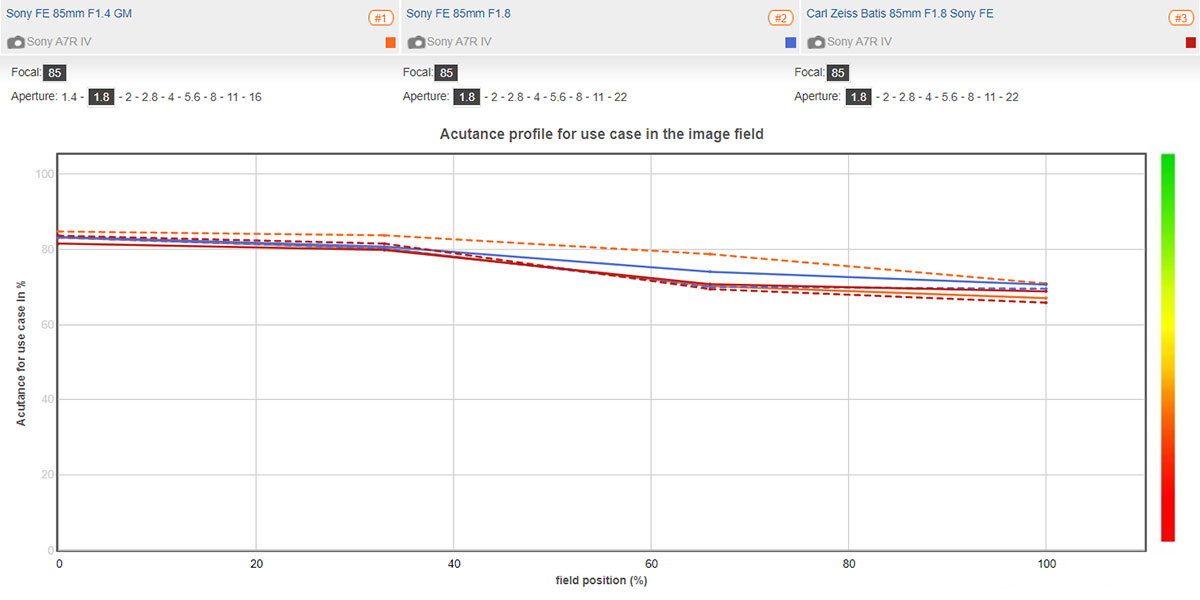



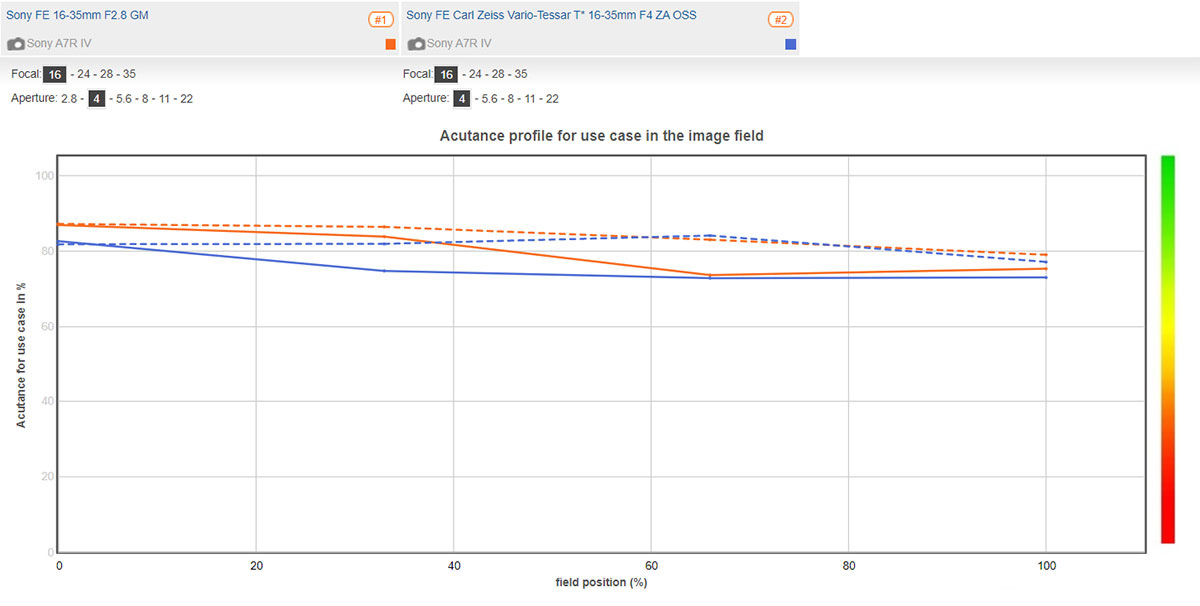


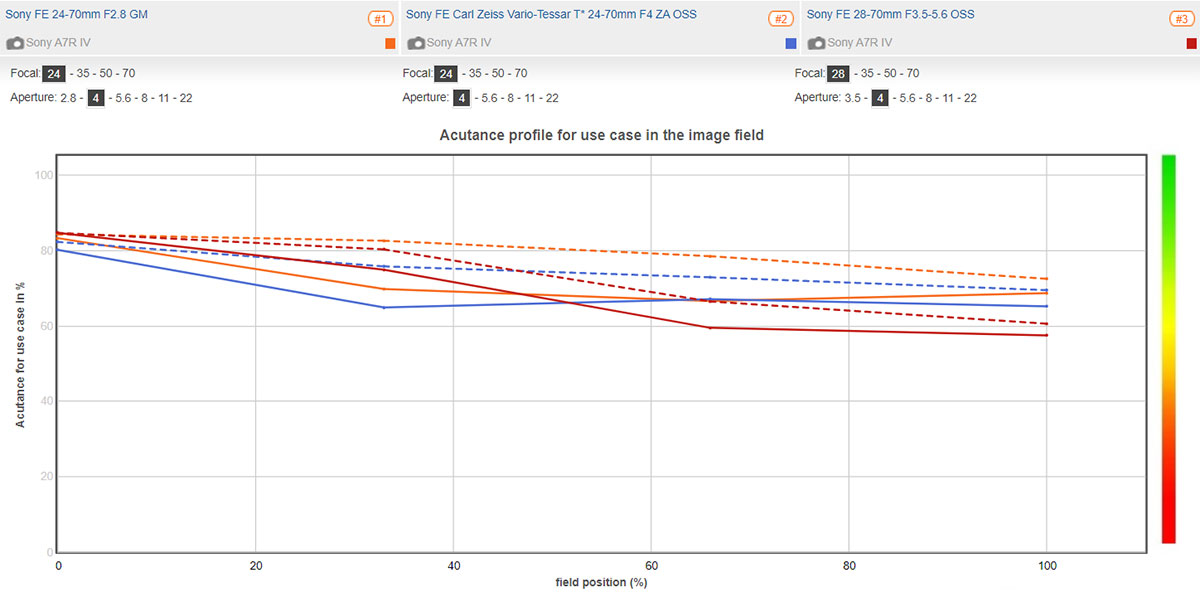


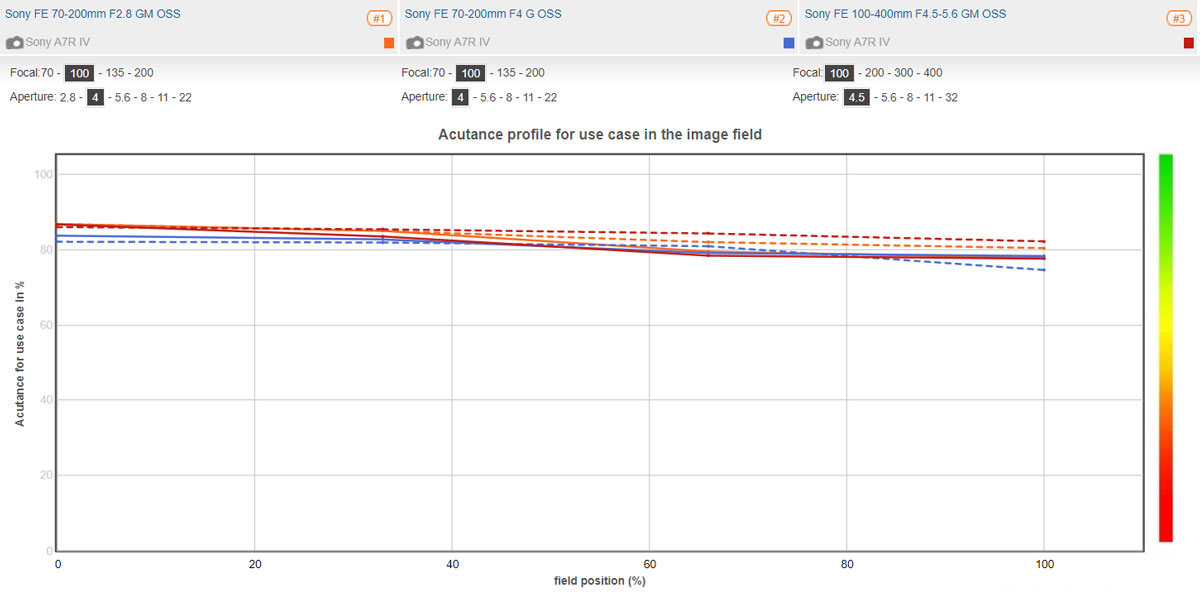
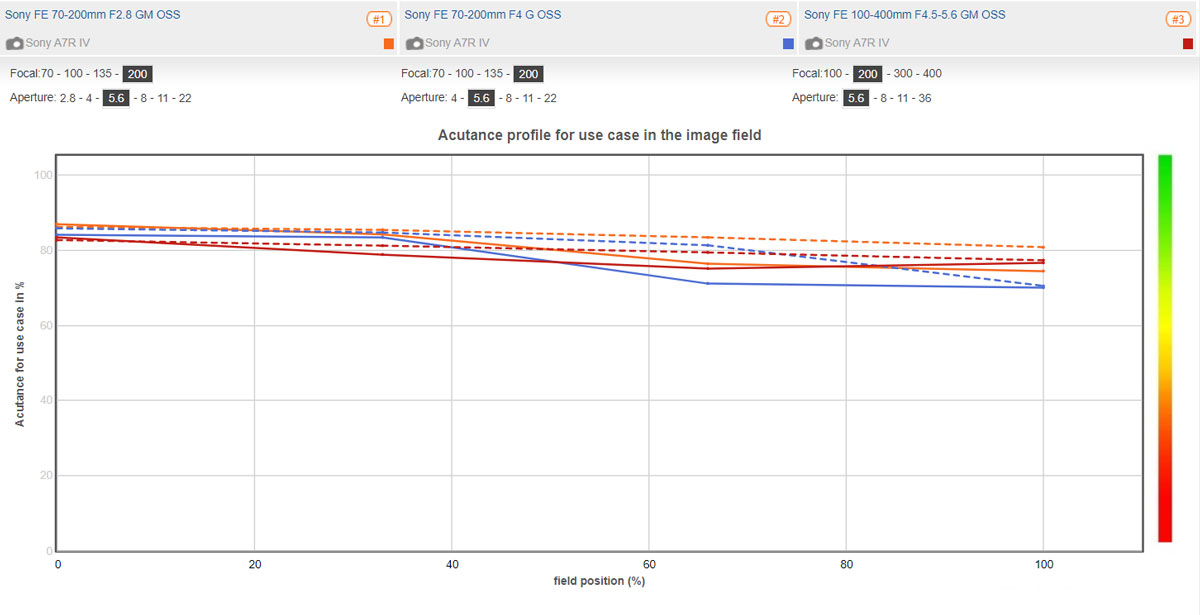
DXOMARK invites our readership (you) to post comments on the articles on this website. Read more about our Comment Policy.